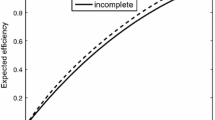Abstract
We present a model in which buyers and sellers use links to trade with each other. Each seller produces a good which can be one of two types. Buyers are ex ante identical but receive specification or valuation shocks after the links are formed. We show that efficient networks are stable and that severing a link in an efficient network results in a higher price for the buyer but a lower price for the seller. We also examine network intermediation when sellers (buyers) form links sequentially. When sellers form links sequentially, the first seller becomes an intermediary and shares links with other sellers; this makes all sellers better off. However, when buyers form links sequentially, buyers may or may not share links. If links are shared multiple intermediaries result.
Similar content being viewed by others
References
Bala V, Goyal S (2000) A noncooperative model of network formation. Econometrica 68: 1181–1229
Biglaiser G (1993) Middlemen as experts. Rand J Econ 24(2): 212–223
Biglaiser G, Friedman JW (1994) Middlemen as guarantors of quality. Int J Indust Organization 12: 509–531
Bondonio D (1998) Predictors of accuracy in perceiving informal social networks. Soc Networks 20: 301–330
Bose RC, Manvel B (1984) Introduction to combinatorial theory. Wiley, NewYork
Casciaro T (1998) Seeing things clearly: social structure, personality, and accuracy in social network perception. Soc Networks 20: 331–351
Cheng LK (2001) Li & Fung Ltd.: an agent of global production. In: Cheng LK, Kierzkowski H (eds) Global production and trade in East Asia. Kluwer, Boston, pp 317–323
Corominas-Bosch M (2004) Bargaining in a network of buyers and sellers. J Econ Theory 115: 35–77
Friedkin N (1983) Horizons of observability and the limits of informal control in organizations. Soc Forces 61: 54–77
Gereffi G (1999) International trade and industrial upgrading in the apparel commodity chain. J Int Econ 48: 37–70
Gilles RP, Chakrabarti S, Sarangi S, Badasyan N (2004) The role of middlemen in efficient and strongly pairwise stable networks, Working paper, Virginia Tech, Blacksburg
Hsing Y (1999) Trading companies in Taiwan’s fashion shoe networks. J Int Econ 48: 101–120
Jackson MO, Watts A (2002) The evolution of social and economic networks. J Econ Theory 106: 265–295
Jackson MO, Wolinsky A (1996) A strategic model of social and economic networks. J Econ Theory 71: 44–74
Johri A, Leach J (2002) Middlemen and the allocation of heterogeneous goods. Int Econ Rev 43: 347–362
Kranton R, Minehart D (2000) Competition for goods in buyer–seller networks. Rev Econ Design 5: 301–331
Kranton R, Minehart D (2001) Theory of buyer–seller networks. Am Econ Rev 91: 485–508
Liu Bih Jane, Yun Lu Alan, Tung An-Chi (2006) Export outsourcing: cost disadvantage and reputation advantage. In: Pan A, Yotopoulos, Donato Romano (eds) The asymmetries of globalization. Routledge, London
Mauleon A, Sempere-Monerris JJ, Vannetelbosch VJ (2005) Networks of manufacturers and retailers. Discussion Paper, Département des Sciences Économiques de l’Université catholique de Louvain
McBride M (2006) Imperfect monitoring in communication networks. J Econ Theory 126: 97–119
Petropoulou D (2005) Information costs, networks and intermediation in international trade. Working paper version, LSE
Rauch JE, Watson J (2002) Network intermediaries in international trade. J Econ Manag Strategy 13: 69–93
Rubinstein A, Wolinsky A (1987) Middlemen. Q J Econ 102: 581–593
Slikker M, van den Nouweland A (2001) Social and economic networks in cooperative game theory. Kluwer, Boston
Spulber DF (1999) Market microstructure. Cambridge University Press, Cambridge
Standing C, Borbely S, Vasudavan V (1999) A study of web diffusion in travel agencies. In: Proceedings of the 32nd Hawaii International Conference on System Sciences, IEEE
Strang G (1986) Introduction to applied mathematics. Cambridge Press, Wellesley
Wang P, Watts A (2006) Formation of buyer–seller trade networks in a quality differentiated product market. Can J Econ
Watts A (2001) A dynamic model of network formation. Games Econ Behav 34: 331–341
Yavas A (1994) Middlemen in bilateral search markets. J Labor Econ 12: 406–429
Author information
Authors and Affiliations
Corresponding author
Additional information
I am grateful to Alison Watts for her time and invaluable suggestions. I would like to thank Paul Melvin, all seminar participants at SIUC and an anonymous referee for their feedback.
Rights and permissions
About this article
Cite this article
Patil, H. Buyer–seller networks with demand shocks and intermediation. Rev Econ Design 15, 121–145 (2011). https://doi.org/10.1007/s10058-009-0097-4
Received:
Accepted:
Published:
Issue Date:
DOI: https://doi.org/10.1007/s10058-009-0097-4




